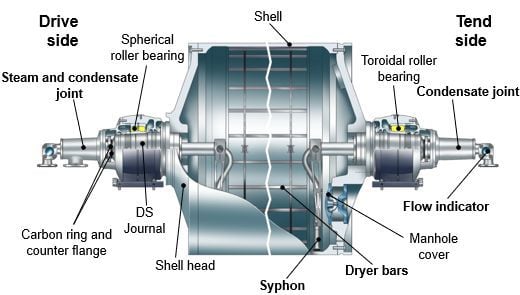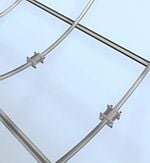Troubleshoot dryers and steam & condensate systems, part 1
Mar 8, 2022
Dryers and steam & condensate systems involve a complicated set of interdependent process values. Changes to one variable cascade to other variable changes. The following are some notes on overall troubleshooting and operations of dryer sections in the mill. Another Up & Running article presents tips for troubleshooting your steam & condensate system.

Valmet dryer cylinder showing steam and condensate elements
Dryer can thermal profiles can cause moisture streaks in the sheet. Use a contact pyrometer 24" in from end, can get friction factor heating. Infrared pyrometers can be used as well and don't have to touch the dryer can, but are affected by varying emissivity. Can be used to check for full cans by measuring the dryer can heads. Can use IR thermography for looking at larger areas, but also vary with emissivity differences. Plot can temperatures down the machine vs. their corresponding steam saturation temperature. If can does not control condensate removal well, temperatures are hotter on ends of cans due to higher turbulence, resulting in frown shaped moisture profiles.
Steam temperature: Higher steam pressures = higher can surface temperatures.
Sensible heat: Heat used to raise water temperature without evaporating it. Can surface is normally cooler for beginning cans than later cans.
Condensate layer: Major resistance to heat transfer (70x less than shell conductivity). Condensate thickness should be about 3mm. Condensate cascades at speeds less than 1000fpm (mixing), and rims above that speed (conduction).
Unorun dryers: Top cans will be cooler than bottom cans (no direct contact with sheet).
Felt wrap and tension: Minimizes boundary air, increases heat transfer and condensing rate and reduces can surface temperature.
Two types of sheet moisture profile problems:
- When moisture profile is inversely related to dryer can surface temperature profile, indicates an issue with condensate removal (high can temperature = low sheet moisture).
- When moisture profile is the same as dry can surface temperature profile, indicates an issue with sheet contact to the can (high can temperature = high sheet moisture).

Sheet moisture: Can temperature increases as moisture is reduced, usually the highest temperature on the last cans.
Superheated steam: Does not contribute to can surface temperature, must be cooled to saturation temperature before condensing, can cause joint issues.
Non-condensable gases: Can reduce dryer can temperature by reducing steam concentration, normally located on non-syphon end of the can.
Dryer can alignment: Unlevel cans cause thermal profiles.
Differential pressure: Needs to set high enough to evacuate the can, but not too high to blow through the syphon without condensing enough.
Dryer grooves: Holds more condensate, lowers heat transfer, resulting in lower surface temperatures.
Press run blow boxes: Help alleviate blowing and drop-off by inducing a vacuum (Bernoulli Effect, Coandă effect).
Single felted dryer sections: Supports weak web. At higher speeds, the sheet wants to release on down-runs. Need blow boxes to pull the sheet off the upper dryer can, and before the bottom can to hold the sheet to the felt. May also need a blow box on the up-run to keep the sheet on the felt and prevent blowing.
Double felted dryer sections: Greater sheet instability between upper and lower cans. By relocating felt rolls toward the wet end, the sheet is better supported by the felt and lower unsupported draw. Blow boxes used in felt roll pockets to help sheet stick to felt as it comes off can. Use ventilating ducts to push air into pockets at the same rate as air is leaving with felts.
Dryer section transfers: Utilize a lick transfer and a blow box to stick the sheet to a new dryer felt. Running top felts 1" apart reduces boundary air.
Dryer pocket humidity variation: Can cause sheet moisture profiles – the higher the humidity = the higher the sheet moisture. Target humidity variation <0.05 lb H20/1b D.A. Opening and closing hood doors can affect sheet moisture if pocket ventilation is not good.
Low temperature steam has more latent heat than high temperature steam. Latent heat is given off when changing from a vapor to a liquid phase.
For assistance troubleshooting your dryer section, contact your Valmet representative.